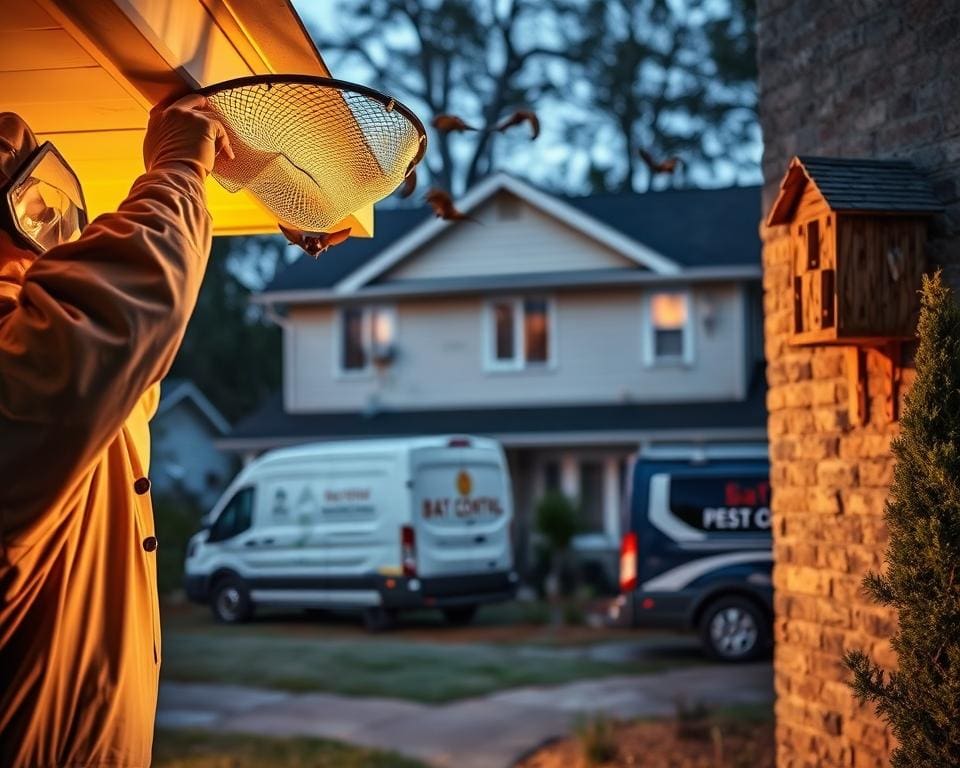Bats can be a common yet troubling issue for homeowners, and knowing how to get rid of bats in the house is essential for maintaining a safe and comfortable living environment. These creatures can enter homes through small openings and, although often misunderstood, play a vital role in our ecosystem. However, an infestation can lead to health risks and property damage, making effective bat control crucial. It’s important to note that bats are protected under UK law, which necessitates the use of humane methods for removal. This article will guide you through various strategies for safe and effective bat removal, ensuring your home remains a bat-free sanctuary.
Understanding Bat Behaviour
To effectively manage a bat infestation, it is crucial to understand bat behaviour. Bats are nocturnal animals, active during the night, which contributes to their elusive nature. During daylight hours, they roost in dark, sheltered locations, making attics, lofts, and eaves prime habitats for these creatures.
Social by nature, bats often form colonies, leading to larger infestations if their presence is not addressed swiftly. Their nesting habits tend to favour warm, undisturbed environments, which can often be found in human structures. Recognising these nesting preferences is key for homeowners aiming to identify potential entry points.
Various species inhabit the UK, each with unique dietary needs, primarily consisting of insects and fruit. Understanding their ecological role is vital, as they contribute significantly to pest control and pollination. Insights into bat behaviour can empower individuals to approach bat management with informed strategies.

Identifying a Bat Infestation
Identifying a bat infestation early plays a crucial role in managing the situation effectively. Homeowners should be aware of the common signs of bats that may indicate their presence. One of the most telling signs includes the discovery of droppings scattered around your home, which resemble small black pellets. An inspection may reveal urine stains or distinctive odours associated with guano, becoming more noticeable in confined spaces such as attics or basements.
Another key method for detecting bats involves listening for scratching sounds, particularly during dusk. Bats are nocturnal creatures, and their activity peaks in the evening. This is a vital time to observe if they are flying in and out of potential entry points around your property.
Recognising these signs of bats promptly will empower homeowners to assess the situation accurately and address the problem before it escalates. Prompt action can prevent the complications associated with prolonged exposure to a bat infestation.
How To Get Rid Of Bats In The House
Many homeowners may overlook the early signs of a bat infestation, but recognising these indicators is crucial for swift action. Detecting the presence of bats in your home can prevent health risks arising from prolonged exposure and unsanitary conditions. Signs of bats include strange noises in the attic or walls, an unpleasant odour, and visible bat droppings. Understanding what to look for will aid in removing bats from home before the situation escalates.
Common Signs of Bats in Your Home
Homeowners should be vigilant about the following indicators of bat activity:
- Strange noises, such as chirping or flapping, coming from hidden spaces
- Visible droppings, often resembling mouse droppings but with a shiny appearance
- Stains or marks around entry points, indicating frequent bat traffic
- Pungent odours, often described as strong or ammonia-like, around nesting areas
Health Risks Associated with Bat Infestation
The presence of bats within a residence creates notable health risks that should not be underestimated. Bat droppings can carry diseases such as histoplasmosis, which may cause respiratory issues if inhaled. Furthermore, the potential transmission of rabies through contact with an infected bat poses a significant concern for both humans and pets. Prompt removal of bats from home is essential to mitigate these risks and maintain a safe living environment.
Effective Bat Removal Techniques
Successfully managing a bat infestation entails employing various effective bat removal techniques. These methods prioritise humane bat eviction, ensuring that bats are not harmed during the process. Understanding these techniques not only fosters a safer environment for both humans and bats but also helps in maintaining local wildlife conservation laws.
Humane Bat Eviction Methods
Humane approaches to bat eviction are essential in ensuring the safe relocation of these creatures. Techniques such as one-way exclusion devices allow bats to exit a building without the possibility of re-entry. These devices are installed at entry points, granting bats the freedom to leave while preventing their return. Other methods may involve creating an inviting atmosphere outside the structure, encouraging bats to find alternative roosting sites.
When to Contact Professionals for Bat Removal
In situations where large infestations occur or structural challenges impede effective bat removal, seeking help from professional bat removal services is advisable. These experts possess the necessary tools and know-how to tackle complex bat issues. Their experience is invaluable in ensuring both effective bat removal and adherence to wildlife protection legislation, offering peace of mind to homeowners concerned about their safety and the wellbeing of bats.
Bat Deterrents to Keep Bats Away
When it comes to protecting your home from unwelcome bat visitors, understanding the various bat deterrents is key. Homeowners can choose between natural repellents and commercial products, each offering unique advantages in keeping these creatures at bay.
Natural Bat Repellents for Your Home
Many individuals prefer using natural bat repellents as a first line of defence. These solutions often contain strong scents that bats find unpleasant. For instance:
- Peppermint oil can be effective when sprayed in areas where bats are likely to enter.
- Ammonia, with its potent odour, serves as a deterrent if placed in open containers in strategic locations.
- Ultrasonic devices, which emit high-frequency sounds that are unbearable for bats, can also play a role in repelling them.
Best Commercial Bat Deterrents
For those seeking convenience and efficacy, several commercial products are designed specifically as bat deterrents. These products often combine advanced technology with effective ingredients to ensure maximum impact. Popular options include:
- High-frequency ultrasonic repellents, which create an uncomfortable environment for bats without harming them.
- Specialised sprays that combine natural and synthetic ingredients to repel bats effectively.
By exploring these natural and commercial bat deterrents, homeowners can implement strategies that suit their needs, fostering a bat-free environment and ensuring peace of mind.
Preventing Future Bat Infestations
Preventing bat infestations begins with understanding the importance of a proactive approach. Sealing potential entry points in your home is vital in these prevention strategies. Inspect your property regularly for gaps in roofs, vents, and eaves, as these are common areas where bats can gain access.
As part of your home prevention strategies, consider the following measures:
- Maintain cleanliness in and around your property to discourage bats from seeking shelter.
- Trim vegetation that may provide cover or access to your home.
- Ensure all windows and doors fit securely, eliminating any gaps.
Regular maintenance of your structures significantly contributes to preventing bat infestations. The more proactive you are, the less enticing your home becomes to these creatures. Creating an environment that is unfavourable for bats will help you maintain a bat-free sanctuary.
The Importance of Bat Exclusion
Bat exclusion plays a crucial role in ensuring the long-term safety and comfort of your home. Preventing bats from accessing your living space requires diligent efforts in sealing entry points effectively. By implementing practical measures, homeowners can create a barrier that reduces the likelihood of bat infestations.
Sealing Entry Points in Your Home
One of the first steps in bat-proofing involves identifying and sealing entry points where bats may infiltrate. Common areas to inspect include:
- Gaps around windows and doors
- Crumbling mortar in brickwork
- Holes in the roof or eaves
- Openings in soffits and vents
Utilising materials like mesh screens and caulking can significantly assist in sealing these vulnerable areas, ensuring bats have no access to your home.
Creating a Bat-Proof Environment
To develop a comprehensive bat-proofing strategy, it is essential to modify the habitat around your property. Bats are attracted to areas that offer shelter and food. Consider these strategies for creating an unwelcoming environment:
- Maintain clean gutters and drains to eliminate insect breeding sites
- Trim trees and shrubs to reduce hiding spots
- Keep outdoor lighting focused away from entryways to deter nocturnal foraging
Regularly checking for and repairing any cracks or openings in your home can further enhance bat exclusion efforts. A proactive approach not only safeguards your living space but also promotes a harmonious coexistence with the natural world.
Maintaining a Bat-Free Home
Creating and maintaining a bat-free home involves consistent effort in both inspections and family education. By adopting proactive measures, families can cultivate an environment that discourages bats from taking residence and keeps everyone safe and informed.
Regular Inspections and Maintenance Tips
Conducting regular inspections is essential for identifying vulnerabilities that may attract bats. Focus on the following areas during your assessments:
- Check for any gaps or cracks in the roof, walls, and foundation, as these can serve as entry points.
- Examine vents, chimneys, and openings around pipes that may need securing.
- Inspect attics and basements regularly for signs of bat activity, such as droppings or physical presence.
Timely maintenance is vital to ensure these areas are kept secure. By prioritising inspection tips, families can greatly reduce their chances of an infestation.
Educating Your Family About Bats
Family education plays a significant role in maintaining a bat-free home. Informing all family members about bats and the myths surrounding them fosters awareness and safe behaviours. Encourage discussions about:
- The ecological benefits of bats and their reduction of pests.
- How to handle bat encounters safely, especially for children.
- Recognising signs of a potential bat presence at home.
By emphasising family education, households can build understanding and preparedness, laying the groundwork for a resilient defence against unwanted bat intrusions.
What to Do If You See a Bat in Your House
Encountering bats in your home can be startling, but the key to managing this situation is to remain calm. The immediate actions you should take involve ensuring that all windows and doors are securely closed to contain the bat in a single room. This not only helps in preventing the bat from flying throughout your home but also allows you to manage the situation more effectively.
Safety precautions are vital when dealing with bats. Directly handling them can pose health risks, so it’s advisable not to attempt capturing them with bare hands. Instead, use a sturdy container, such as a box or a jar, to gently trap the bat. Once contained, you can safely release it outside, ideally during twilight when it is most active. Remember, your aim should always be to handle the situation as humanely as possible.
Being prepared for unexpected encounters with bats is essential. By following these guidelines, you not only protect yourself and your family but also contribute to the welfare of these fascinating creatures. Understanding what to do in such situations empowers you to maintain a safe and harmonious living environment while respecting wildlife.









